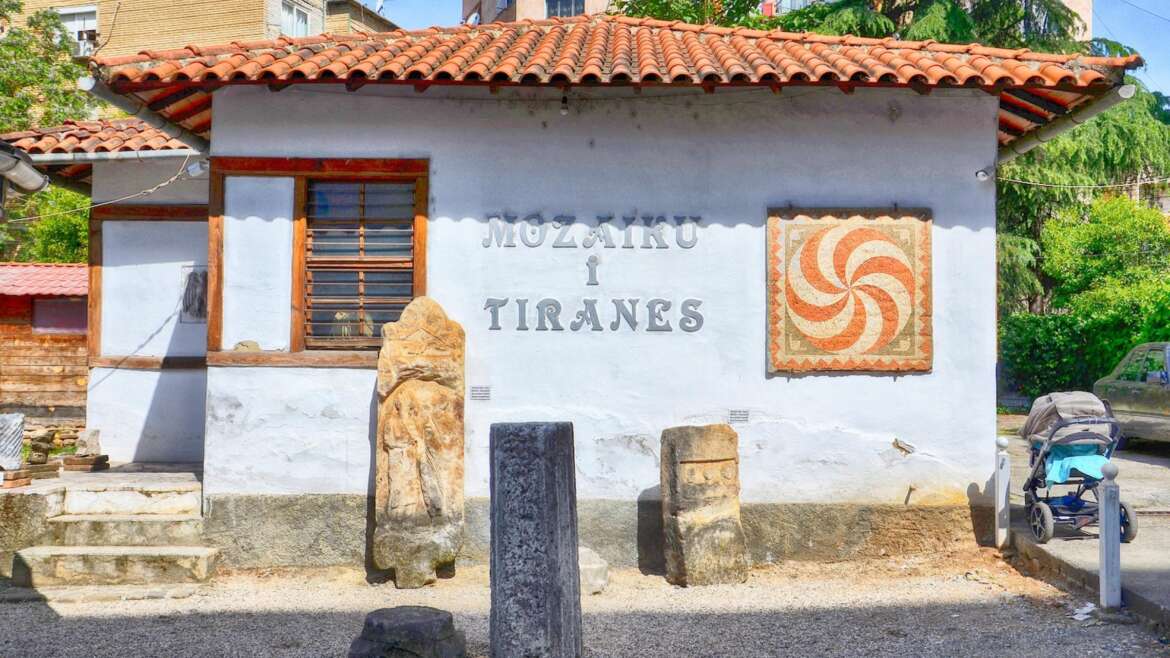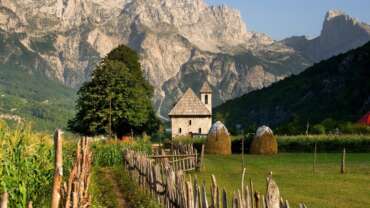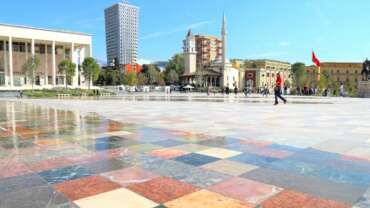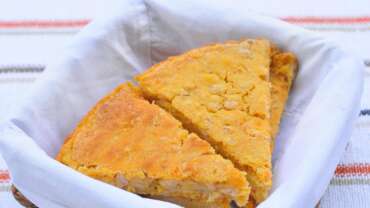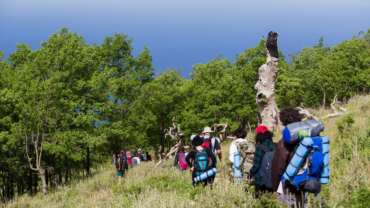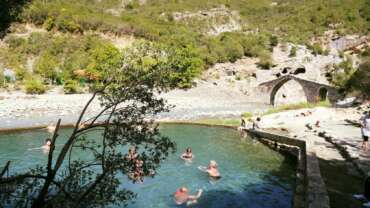Cultural & Heritage Tourism in Albania
Ancient Mosaic of Tirana
The ancient Tirana Mosaic it is believed to have been part of a 3rd century Roman house, referred to by local archeologists as the ‘Villa rustica’. Later, in the 5th and 6th centuries, a Paleo-Christian Basilica was built around this site. It was declared a cultural monument of the first category in June 1973. The ruins of this Paleo-Christian Basilica were discovered in 1972. In 2002, some other objects were found around the ruins of the house, and today they form the Archaeological Complex of the Mosaic of Tirana. It is the only archaeological monument within the city. Some of the ancient mosaics discovered at the site that feature diverse geometrical patterns and depict poultry and fish. It was re-opened to the public on 23 January 2010.
Archaeological Museum Durres
The Durrës Archaeological Museum (Muzeu Arkeologjik) in Durrës, Albania, established in 1951, is the largest archaeological museum in the country. The museum is located near the beach and north of the museum are the 6th-century Byzantine walls, constructed after the Visigoth invasion of 481.
Collection
The bulk of the museum consists of artifacts found in the nearby ancient site of Dyrrhachium and includes an extensive collection from the Ancient Greek, Hellenistic and Roman periods.[3][4] Items of major note include Roman funeral steles and stone sarcophagi, an elliptical colourful mosaic measuring 17 by 10 feet, referred to as The Beauty of Durrës, and a collection of miniature busts of Venus, testament to the time when Durrës was a centre of worship of the goddess.
Reconstruction
In 2010, the Durrës Archaeological Museum is expected to undergo a total reconstruction.Despite the importance of archaeological objects, the museum is not an independent institution and is operated by the Regional Directorate of Durrës Monuments. The museum is supported by the Albanian Institute of Archaeology and the Academy of Sciences and intend it to become a national museum according to archaeologists such as Adi Anastasi and Luan Përzhita, given the historical significance of its artifacts and their illustration rich cultural heritage. A fund has been opened by the Ministry of Tourism, Culture, Youth and Sports to provide the museum with a new research unit, its own scientific staff and laboratory and administrative body. Problems have been identified in the reconstruction process given that the museum is located near the sea faces erosion from the iodine content of salt and moisture and weathering.
Bunk’Art 1&2
Bunk’Art 1 contain the Anti-atomic bunker of the Albanian Army during Communist time , that is located near Mount Dajti . The Bunker contain more than 100 rooms and for military and government purpose during a possible Atomic war. Bunk’Art 2 contain an Anti-Atomic bunker of Interior Ministry of Communist era that was projected for the governance of Tirana in case of war. The museum contain more information about the Albanian Police of the time but also for the Prisons , Working camps and the victims of communism . The two spaces are now used as museum of that era but also for happening , exhibitions , concerts and different type of events.
Communism Legacy
The legacy of Communism is still visible in Albania, where over 200,000 concrete bunkers dot the landscape. Built by the Enver Hoxha regime over the course of 40 years, these bunkers were designed to thwart a military invasion of the country. While they were of little defensive value to Albania, today they are an interesting attraction to the country’s visitors. Albania’s bunkers can be found in all different shapes, sizes and colors. Main attractions are The Anti-atomic Bunker Bunk’art 1 near Dajti Mountain and Bunk’art 2 near the Ministry of Interior , The Museum of Secret Surveillance of the infamous Sigurimi , Post Bllok monument in Tirana, the Bunker of Gjirokaster, Museum of Dictatorship Terror , Diocesan Museum in Shkoder.
When it seized power in November 1944, the new Communist government took immediate measures to consolidate its power.
In January 1945, a special people’s court was set up in Tirana under Koçi Xoxe (1917-1949), the new minister of the interior from Korça, for the purpose of trying Amajor war criminals.” This tribunal conducted a series of show trials which went on for months, during which hundreds of actual or suspected opponents of the regime were sentenced to death or to long years of imprisonment. In March, private property and wealth were confiscated by means of a special profit tax, thus eliminating the middle class, and industry was nationalized.
The communist leadership in Albania, always plagued by factional division, had split into two camps shortly after it took power. The rift between Tito and Joseph Stalin in 1948 gave Enver Hoxha a Soviet ally with whose support he could now act to preserve his own position, and he soon managed to eliminate his rivals. By June 1948, after several years of Yugoslav tutelage, Albania entered the Soviet fold.
Albania’s alliance with the Soviet Union had several advantages. The Soviets offered much food and economic assistance to replace the losses caused by the interruption of Yugoslav aid. They also gave the Hoxha regime military protection both from neighboring Yugoslavia and from the West at a time when the Cold War was at its height. As Albania had no common border with the Soviet Union, there was no immediate risk of direct political absorption, and the Albanian leadership was in many ways very mindful of preserving the country’s formal independence.
Integrated into the Soviet sphere, Albania entered a period of profound isolation from the rest of the world. “Ndërtojmë socializmin duke mbajtur në njërën dorë kazmën dhe në tjetrën pushkën” (We are building socialism with a pickaxe in one hand and a rifle in the other) was the slogan spread by the party to create a state-of-siege mentality that would stifle all opposition. By 1955, Albania had become the epitome of a Stalinist state, with Soviet models being copied or adapted for virtually every sphere of Albanian life.
However, when Nikita Khrushchev (1894-1971) denounced Joseph Stalin’s crimes and personality cult in a secret report to the 20th congress of the Soviet Communist Party in February 1956, Enver Hoxha decried revisionism. After some shrewd and ruthless political manoeuvering, he managed to overcome criticism of his own Stalinist policies and maintain power.
By December 1961, the Soviet Union broke off diplomatic ties with Albania, and Enver Hoxha, in search of a new patron, turned his attention to the Far East. The Sino-Albanian alliance, which was to last from 1961 until July 1978, radicalized political, economic and social life in Albania and isolated the country even more from Europe and the rest of the world. The People’s Republic of China provided Albania with much development assistance, including goods and low-interest loans, but this aid did not prove to be enough to promote economic growth.
In order to stem the tide of popular dissatisfaction with his rule, Enver Hoxha employed his usual tactic of counterattack, launching a Chinese-style campaign at the end of 1965 for the Arevolutionizing of all aspects of life in the country,” a campaign which coincided with the Cultural Revolution in China.What followed from 1973 to at least 1975 was a reign of terror against Albanian writers and intellectuals, comparable, in spirit at least, to the Stalinist purges of the 1930’s. These years constituted the major setback for the development of Albanian culture. A series of purges kept other sectors of society, indeed the whole population, in a state of confusion and insecurity. With the demise of Enver Hoxha on 11 April 1985, political power fell to his successor Ramiz Alia of Shkodra, who ruled the country with a slightly gentler hand, although with no fundamental change of policy.
The foundations of the Communist system were finally shaken in early July 1990 when thousands of young Albanians risked their lives to seek political asylum in the German, Italian and French embassies in Tirana. Within half a year, the one-party dictatorship which had dominated all aspects of Albanian life for almost half a century had imploded. Political pluralism was introduced in December 1990, and the country’s first multiparty elections were held on 31 March 1991.Incredible as it now seems in retrospect, even to the Albanians themselves, orthodox Stalinism survived unscathed and unabated in Albania for a whole 37 years after Stalin’s death in 1953.
Though a definitive judgment on the Asocialist” period in Albania will have to be left to historians and political scientists of the future, the legacy of 46 years of Asplendid isolation” under Marxist-Leninist rule seems to have bequeathed the country with little more than universal misery and a backward economy. When one-party rule was finally done away with, there was virtually no intellectual leadership left to fill the void. Albania’s tiny socialist economy and its society lay in ruins. The beginning of the 1990s thus found the Albanian nation in a state of political, economic and social catastrophe.
Albania’s Bunkers by Robert Elsie
The legacy of Communism is still visible in Albania, where over 700,000 concrete bunkers dot the landscape. Built by the Enver Hoxha regime over the course of 40 years, these bunkers were designed to thwart a military invasion of the country. While they were of little defensive value to Albania, today they are an interesting attraction to the country’s visitors. Albania’s bunkers can be found in all different shapes, sizes and colors. There are some projects to convert the bigger ones into basic hotel rooms, while others have already been transformed by enterprising Albanians, transformed into beverage stands and burger shops. The bunkers have been built into the very fabric of everyday life in Albania, and you will undoubtedly see them during your visit. To understand why these bunkers were built is to understand the totalitarian, communist regime of Enver Hoxha. Perpetually paranoid of an invasion by a foreign power, the Hoxha dictatorship mandated the construction of a defensive infrastructure so elaborate that it would make it unacceptably costly for any would-be attacker. Building hundreds of thousands of concrete fortifications, despite nearly bankrupting the country in the process, was his coping mechanism for this paranoia. However, when we consider that Albania was never invaded during Hoxha’s tenure in power, one cannot help but wonder whether or not his bunker-building campaign wasn’t successful after all.
Edward Lear’s trip in Albania
Edward Lear (1812-1888) was a pretty incredible man for his time. Not many got the chance to travel as much as he did back then (if at all), and they especially didn’t get to travel in the way that he did. Edward Lear was an English landscape and portrait artist who taught Queen Victoria how to wield a paintbrush. He also traversed many lands that were curious and indeed very exotic at that time in history. Throughout his life, he travelled extensively in Italy, Albania, Greece, Egypt, and India, venturing along a slow and cultural path, often meeting up with well-placed friends on the way. He was by no means a one-trick pony, though. As well as creating scenes of some of the most well-known landscapes in the world, Lear was also a handy poet and writer, known mainly for his array of ‘nonsense’ works that use both real and made-up words. Today, I thought I’d share some of Lear’s incredible drawings with you, spanning all across the globe from a time we can only imagine. I’ll let the pieces do the talking.
Folklore Activities
National Festival of Folklore This is the most important event on folklore in Albania. It is organized in Gjirokastra Castle every four years. All Albanian folklore groups participate together with Albanian groups from Kosova, Montenegro, Macedonia the arbëresh of Italy, Turkey, the United States, Greece and other countries. Folklore groups from other countries as well as international guests participate as well. “National Typology Festival of Saze and Folk Orchestras”, Korça Saze (Albanian traditional clarinet) music is played throughout southern Albania and especially in urban centers such as Korça, Vlora, Pogradeci, Përmeti, Berati, Leskoviku,etc. “National Festival of Rhapsodists and Folk Instrument Players”, Lezha This festival showcases rhapsodists from Northern Albania. It is the only event that is wholly dedicated to rhapsodists and bards who interpret their songs with instruments such as lahuta, (a very special instrument with only one wire ) çifteli and sharki. “National Festival of Urban Folk Songs”, Elbasan This festival is organized every March as a tribune of folk songs from Albanian urban centers where inherited traditional music has been revised through more modern methods of orchestration and interpretation. The resulting sounds and rhythms are therefore more fresh and dynamic and require less of an acquired taste for Albanian folk. The Festival is organized on the first day of spring which is a traditional celebration in Elbasan. Every group competes by representing the music of its particular region. The festival also helps promote the most talented young singers and players of Albanian urban folk music. “National Festival of Iso-Polyphony”, Vlora The National Typological Festival of Iso-Polyphony is a powerful promoter of one of the most original strands in Albanian folk music iso-polyphony. The festival not only helps promote iso-polyphony in areas beyond its immediate reach, but it also helps the regions where iso-polyphony is a tradition to maintain and further develop this wonderful type of singing. On 25 November 2005, UNESCO declared Albanian Iso-Polyphony “Masterpiece of the Oral Inheritance of Human Kind”. “National Festival of Folk Instruments”, Gjirokastra This is a multicultural event where besides the festival showcasing folk music instruments in Gjirokastra Castle, fairs, book promotions, seminars and other events are organized in Gjirokastra’s historical center. The event promotes cultural tourism and local business in the city. “International Festival Multicultural Përmet”, Përmet This is the only international festival of ethnic, cultural and linguistic minority in Albania under the patronage of CIOFF, an international organization that promotes folklore. The Albanian CIOFF branch is located in Përmet. This event is a great asset to Albanian folklore as it helps promote it in the international stage. Përmet was selected to hold a festival for minorities because in this setting a number of cultural traditions from different minorities coexist with each other. Moreover, it is the city where masters of Albanian folk such as Laver Bariu, Mentor Xhemali, Remzi Lela, etc., were born. Beside the festival, a number of other activities such as symposiums, shows and book promotions are organized in the town. By showcasing the musical traditions of minorities, the festival promotes peace and understanding between ethnic groups of the region. Folklore Festival “Sofra Dardane”, Tropoja The festival aims to promote research, preservation and enrichment of Northern Albanian and Kosovo folklore and ethnography. The two are grouped together because the cultural foundation of both regions is one and the same. The competition is held in the town’s main square and in the beautiful Valbona valley thus combining tradition, music and nature. Festival “Oda Dibrane”, Peshkopi Although “OdaDibrane” started only in 1994, now it has become a tradition of humorous dances and songs. The festival brings under one roof Albanian artists from throughout the world. Ancient rites, allegory and comedy are all showcased here at the accompaniment of traditional music instruments. Parallel to the festival, a number of other shows such as photography exhibitions, painting exhibitions and others are organized. Beauty Folklore Contest “Logu i Bjeshkeve” , Malësi e Madhe Years before in Kelmendi area an event called the ‘Log of the Brights’ used to take place. The routs of it are in religious ceremonies that took place in the churches of the villages Selcë, Vermosh, Vukël. Inhabitants from everywere used to come to the holy ceremony. After the ceremony, people went out of the church and all the Brights of that year used to show themselves dressed in traditional clothes that were with many colors.Meanwhile the fist started with a traditional dance of the area called ‘the dance of Logu’. The fist continued with songs, dances, and the nicest bright was selected.
Gjon Mili Photography Museum
Gjon Mili Museum The American photographer Gjon Mili with Albanian origin, now has a museum in the city of its origin, Korçë. Many world famous photos taken by the photographer are exposed in the museum. Gjon Mili is known as the photograph who used for the first time electronic flash photography movement. Gjon Mili was born on November 24, 1904 in Korçë. At the age of 5 his family emigrated to Romania. There he did the high school and at the age of 19 he went to America. He graduated in the Institute of Technology of Massachusetts as lighting engineer. During this time he dealt with photographic art. The Museum dedicated to him is in the city of Korca in Albania stabilised at “The Romanian House” just in the center of Korca . Gjon Mili is one of the greatest photographers of the 20th century.
Historical Museum of the Armed Forces
The Historical Museum of the Armed Forces is located in the premises of the Doctrine and Training Command of Albanian Army. This museum was set up on the occasion of the 100th anniversary of the establishment of the Albanian Army. It contains more than a thousand museum artefacts, from the Middle Ages to the XIX century, decorated with gold and silver, a range of display cases with rifles of various types of Medieval, Renaissance, Skanderbeg’s swords, of Ali Pasha Tepelena, aircraft, helicopters, tanks, four silhouettes, ground artillery, anti-aircraft of various calibers, as well as transport vehicles of different types. The two main pavilions are: the historic era pavilion 1470-1945 and the pavilion of 1945-1990. On the second floor are part of the uniforms used during the years by the Armed Forces to the newest uniforms. The first pavilion, besides the historical values, is also a testimony of the Albanian handcrafts in this area.
House of Leaves
New Museum dedicated to the famous “Sigurimi” the Albanian Secret Surveillance Service of the Communism era that was famous for spying everywhere and every person in the Dictatorship time. Built in 1931 and used initially as a clinic, the House of Leaves became during the Communist period a security office used both as a listening post and a place of torture. Today the building is turned into the Museum of Secret Surveillance and aims to portray the omnipresence of the Albanian totalitarian control.
Iso-Polyphony
Albanian iso-polyphony is a traditional part of Albanian folk music and as such is included in UNESCO’s intangible cultural heritage list. Among Albanians, all four regions of Lalëria (Myzeqe), Toskëria, Çamëria, and Labëria have the polyphonic song as part of their culture. Among Albanians a related form of polyphonic singing is also found in northern Albania in the area of Peshkopi, the Albanian communities of Kaçanik in Kosovo, the areas of Polog, Tetovo, Kičevo and Gostivar in Macedonia and the region of Malësia in northern Albania and southern Montenegro. The region of Labëria is a particular region for multipart singing. Songs can be of two, three, or four parts. Two part songs are sung only by women. Three part songs are more diffused and can be sung by men and women. Four part songs are a Labëria specialty. Research has shown that four part songs have come after three part ones and that they are the most complex form of polyphonic singing. The Gjirokastër National Folklore Festival, Albania, (Albanian: Festivali Folklorik Kombëtar), has been held every five years in the month of October since 1968, and it has typically included many polyphonic songs.
Korca National Museum of Medieval Art
Korçë’s National Museum of Medieval Art was established back in 1980, and houses some 7,000 items of immeasurable historical and cultural significance. Stone, metal, wooden, and fabric items from Albania’s iconography are presented. Also, collections of paintings from the Korça school, are on display here, as well. Housed in what was the Korça Cathedral, the museum is a must see attraction for history and art lovers. The museums objects de art range from anonymous religious icons of the 13th and 14th Centuries, as well as well known pieces from noted artists like; Onufri, Jeromak Shpataraku, David Selenica, Onufer Qiprioti, Teacher Kostandini, and the Zografi Brothers, among the many others. This museum collection is, by far, one of the finest in all Albania.
Marubi National Museum of Photography
The Marubi Photo Collection (Fototeka Marubi) now National Museum of Photography in Shkodra comprises over 150,000 photos, many of which are of great historical, artistic and cultural significance. It was compiled by three generations of photographers. Pietro Marubbi or Marubi (1834-1903) was an Italian painter and photographer who, as a supporter of Garibaldi, had emigrated from Piacenza, Italy, to Shkodra for political reasons around the year 1850. There, he founded a photo business, Foto Marubi, with cameras he had brought with him. The oldest photos in the collection date from 1858- 1859. Some of them were published in The London Illustrated News, the La Guerra d’Oriente and L’Illustration. Marubi was assisted by the young Rrok Kodheli (1862-1881) and his brother, Kel Kodheli (1870-1940), the latter of whom took over the family business after Pietro’s death and changed his name to Kel Marubi. He furthered techniques with special effects and learned to retouch the negatives. He also began photographing outside the studio with more advanced cameras. Closely related to the Marubis was the photographer and painter, Kolë Idromeno (1860-1939), of Shkodra. With the help of Pietro Marubbi, from whom he learned the art of photography, the young Idromeno was able to travel to Venice in 1875 to attend the Academy of Fine Arts. However, he could not endure the rigors of formal training and gave up after six months. He remained in Venice though, and worked for a few years as the assistant of an established Venetian painter, returning to Albania in 1878. In 1883, he opened a photo studio with cameras imported from the Pathé Company in France. In 1912, he became the first person in Albania to import moving picture equipment and to show films. In August of that year, he signed a contract with the Josef Stauber Company in Austria to set up the country’s first, rudimentary public cinema. The third generation of Marubi photographers in the family was Kel’s son, Gegë Marubi (1907-1984). He studied in Lyon in 1923-1927 at the first school of photography and cinema, founded by the Lumière brothers, and worked in Shkodra as a professional photographer from 1928 to 1940. He pioneered working with celluloid instead of glass plates. The Marubi photo collection captures and documents northern Albanian history from the League of Prizren onwards. It contains fascinating photographs of tribal leaders, highland uprisings, town life in Shkodra and various public events. Only a few of the photos have been published. Attempts have been underway since 1994, with UNESCO funding, to preserve the collection and make it available.



